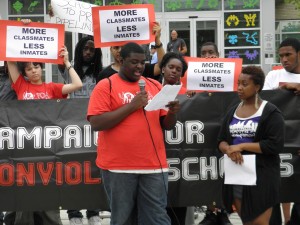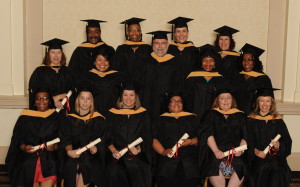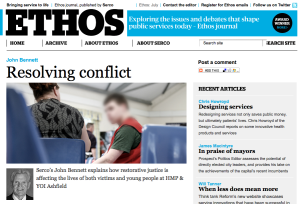News & Announcements
 from the CNS Press ConferenceStudents and community activists in Philadelphia are not satisfied with the new draft of the school district's discipline code, according to an article the other day in the Notebook, which bills itself as "an independent voice for parents, educators, students and friends of Philadelphia public schools." According to the article, "Students push for changes in District's discipline policy" by Katie McCabe, members of the Campaign for Nonviolent Schools (see this blog post on past actions of this group) and others community groups were given input on the most recent draft of the code. But School Reform Commissioner Lorene Cary agrees the draft does not address student's major concerns. In response to the student feedback, "District officials are now working to write another draft of the code that is more responsive to student feedback."
from the CNS Press ConferenceStudents and community activists in Philadelphia are not satisfied with the new draft of the school district's discipline code, according to an article the other day in the Notebook, which bills itself as "an independent voice for parents, educators, students and friends of Philadelphia public schools." According to the article, "Students push for changes in District's discipline policy" by Katie McCabe, members of the Campaign for Nonviolent Schools (see this blog post on past actions of this group) and others community groups were given input on the most recent draft of the code. But School Reform Commissioner Lorene Cary agrees the draft does not address student's major concerns. In response to the student feedback, "District officials are now working to write another draft of the code that is more responsive to student feedback."
 The IIRP Class of 2012Saturday June 23 was a beautiful day for the commencement ceremony of the fifth graduating class of the IIRP Graduate School, held in the Grand Ballroom of the Hotel Bethlehem in Bethlehem, Pennsylvania, USA.
The IIRP Class of 2012Saturday June 23 was a beautiful day for the commencement ceremony of the fifth graduating class of the IIRP Graduate School, held in the Grand Ballroom of the Hotel Bethlehem in Bethlehem, Pennsylvania, USA.
Jeffrey Lyle Farr, Julia E. G. Getty, Angela Lorraine Hankins, Donald Lloyd Jackson, Stacy R. Phillips and Sharon Rose Jones Witbeck received Master of Science in Restorative Practices and Education.
Jacqueline Joyce Exum, Mary Jo Hebling, Robin C. Ide, Stephanie Mitchell, Yvonne Platts, Amarfi Ramirez-Acevedo, Michele Courtney Reinert, Eileen K. Richards, Alyssa Schmoyer and Josephine Torres-Boykins received the Master of Science in Restorative Practices and Youth Counseling.
This article, with a rather sensational title, "Shoplifters in Hull could be forced to apologise to victims instead of being prosecuted," discusses what sound like a great new scheme coming out of Hull, UK – the first municipality we know of to aspire to become a "restorative city." The part I quibble with is the phrase "forced to apologise." That sounds to me like something the newspaper put into the story rather than a true representation of the process being promoted.
According to the story, the scheme would give shop owners who have been victimized by shoplifters an opportunity to meet the young offenders face to face to tell them how they feel and explain to them the impact of their actions. The process would be voluntary and would not exclude the possibility of criminal prosecution.
I've often thought that there would be, and I have occasionally seen suggestions of, links between the Occupy Wall Street movement, with its emphasis on inclusivity and consensus processes, and restorative practices, restorative justice and circles. In this piece by OWS member Stephan Geras about recent trainings by Kay Pranis in New York City, that hunch is confirmed. Below are some key passages in Geras's post at ZNet, "Restorative Justice at OWS." All added emphases below are mine.
 In a resolution dated June 12, 2012, the Michigan State Board of Education states its call to end zero tolerance policies in no uncertain terms:
In a resolution dated June 12, 2012, the Michigan State Board of Education states its call to end zero tolerance policies in no uncertain terms:
Given the steadily increasing use of zero tolerance policies, the alarming rate of suspensions in school districts across Michigan, the lack of evidence these policies improve safety, and negative impact these disciplinary actions are having on student outcomes, the State Board of Education calls for schools across the state to adopt discipline policies without mandated suspension or expulsion for issues that do not involve weapons.
The Board, along with the Superintendent of Public Instruction, remains absolutely committed to policies that preserve the safest environment possible for students, staff, and volunteers in all of the state’s schools. There is a mounting body of evidence, however, that suggests safety can be maintained, and educational outcomes can be improved, by reducing the number of student suspensions and expulsions.
 Here are two passages excerpted from a piece in Ethos Journal by John Bennet, Restorative Justice Advisor at a youth detention facility in the UK. The first passage focuses on the use of youth meeting their victims in the prison, with a very high rate of success from the victim's point of view. These sound like victim offender mediation meetings, rather than full blown conferences, but they do seem to include the victim's, if not the offender's, family as well. The second passage describes use of what I imagine to be a more informal process internally, between youth in conflict or a youth and teacher.
Here are two passages excerpted from a piece in Ethos Journal by John Bennet, Restorative Justice Advisor at a youth detention facility in the UK. The first passage focuses on the use of youth meeting their victims in the prison, with a very high rate of success from the victim's point of view. These sound like victim offender mediation meetings, rather than full blown conferences, but they do seem to include the victim's, if not the offender's, family as well. The second passage describes use of what I imagine to be a more informal process internally, between youth in conflict or a youth and teacher.
Youth Offenders Meet Victims and Families While in Prison
The biggest but most rewarding challenge for Ashfield is to encourage Youth Offending Teams (YOT) to hold RJ meetings at the prison. These take place between external victims and the young people in Ashfield who committed the crime. For this type of meeting, a facilitator from the relevant YOT approaches the victim to ascertain if they might be open to the idea of a face-to-face meeting with the perpetrator/s of the crime that affected them. The RJ co-ordinator in Ashfield then approaches the young person concerned, and risk assessments are undertaken before the meeting takes place. We have held 16 of these meetings to date, for crimes ranging from arson and assault to car crime and burglary.
 Mike Licht at FlickrCreativeCommons - Attribution LicenseHere's a fascinating suggestion, that journalists who print inaccurate stories that subsequently have a damaging effect on those they write about should be offered restorative justice first.
Mike Licht at FlickrCreativeCommons - Attribution LicenseHere's a fascinating suggestion, that journalists who print inaccurate stories that subsequently have a damaging effect on those they write about should be offered restorative justice first.
David Brindle, reporting for the Guardian (UK) writes:
Restorative justice schemes have been pioneered in the criminal justice sector, whereby a convicted offender can be forced to meet their victim and be invited to apologise. The idea has spread to conflict resolution in workplaces, schools and the community.
Here's a great little video just put out by San Francisco Unified School District (SFUSD) letting children and teens talk for themselves about their feelings and reactions to the implementation of restorative circles and restorative practices in their schools. The caption under the video on youtube reads:
"SFUSD has rolled out a District-wide implementation of Restorative Practices in dozens of schools. Restorative Practices is based on the assumption that students respond better when things are done WITH them rather than TO them. Students exposed to Restorative Practices reflect on how they feel regarding the use of Restorative Circle in the classroom."
 The Fall Intensive is a rare opportunity to explore the full potential of restorative practices: a powerful four-day experience that will immerse you in the restorative culture of CSF Buxmont schools for delinquent and at-risk youth (IIRP demonstration programs), followed by two days of core restorative practices professional development. After two days of firsthand involvement in the restorative environment of a CSF Buxmont school, you can immediately deepen your understanding by learning about what you’ve just experienced.
The Fall Intensive is a rare opportunity to explore the full potential of restorative practices: a powerful four-day experience that will immerse you in the restorative culture of CSF Buxmont schools for delinquent and at-risk youth (IIRP demonstration programs), followed by two days of core restorative practices professional development. After two days of firsthand involvement in the restorative environment of a CSF Buxmont school, you can immediately deepen your understanding by learning about what you’ve just experienced.
Interdisciplinary Conference
This interdisciplinary conference will provide an international perspective on restorative practices theory and practice in a variety of settings, including education, social welfare, criminal justice, community development and workplaces. Restorative practitioners from around the world will share their knowledge and achievements and find encouragement, support and advice.

